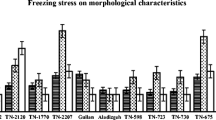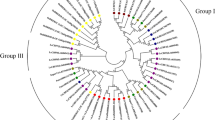Abstract
Cold stress is one of the major limiting factor in crop productivity. Plants growing in colder regions acclimatize to severe conditions owing to the presence of ‘cold stress tolerant genes’. Isolation and functional characterization of these genes are important before their exploitation in modern agricultural practices. Here, we have cloned full length NAC gene (1,388 bp) from Lepidium latifolium (LlaNAC). This gene belongs to NAP sub-group which also includes ANAC056 of Arabidopsis thaliana, nearest relative of LlaNAC. Upstream analysis and microarray data analysis of ANAC056 suggested that LlaNAC might also be ABA-regulated. However, quantitative transcript expression analysis revealed that LlaNAC transcript upregulated by cold stress and downregulated in response to varying concentrations of abscisic acid, salicylic acid, calcium chloride and ethylene. There is also a possibility that the gene may be getting regulated by a pathway whose components are still unknown. Any further investigations to understand the mechanism of regulation of LlaNAC gene expression are likely to find immense importance in plant biotechnology and crop improvement.






Similar content being viewed by others
References
Thomashow MF (1999) Plant cold acclimation: freezing tolerance genes and regulatory mechanisms. Ann Rev Plant Physiol Plant Mol Biol 50:571–599. doi:10.1146/annurev.arplant.50.1.571
Fowler S, Thomashow MF (2002) Arabidopsis transcriptome profiling indicates that multiple regulatory pathways are activated during cold acclimation in addition to the CBF cold response pathway. Plant Cell 14(8):1675–1690. doi:10.1105/tpc.003483
Lee BH, Henderson DA et al (2005) The Arabidopsis cold-responsive transcriptome and its regulation by ICE1. Plant Cell 17(11):3155–3175. doi:10.1105/tpc.105.035568
Hewezi T, Leger M et al (2006) Transcriptional profiling of sunflower plants growing under low temperatures reveals an extensive down-regulation of gene expression associated with chilling sensitivity. J Exp Bot 57(12):3109–3122. doi:10.1093/jxb/erl080
Nakashima K, Tran LSP et al (2007) Functional analysis of a NAC-type transcription factor OsNAC6 involved in abiotic and biotic stress-responsive gene expression in rice. Plant J 51(4):617–630. doi:10.1111/j.1365-313X.2007.03168.x
Aslam M, Sinha VB et al (2010) Isolation of cold stress-responsive genes from Lepidium latifolium by suppressive subtraction hybridization. Acta Physiol Plant 32(1):205–210. doi:10.1007/s11738-009-0382-4
Monroy AF, Dryanova A et al (2007) Regulatory gene candidates and gene expression analysis of cold acclimation in winter and spring wheat. Plant Mol Biol 64(4):409–423. doi:10.1007/s11103-007-9161-z
Kim SG, Kim SY et al (2007) A membrane-associated NAC transcription factor regulates salt-responsive flowering via FLOWERING LOCUS T in Arabidopsis. Planta 226(3):647–654. doi:10.1007/s00425-007-0513-3
Hu HH, You J et al (2008) Characterization of transcription factor gene SNAC2 conferring cold and salt tolerance in rice. Plant Mol Biol 67(1–2):169–181. doi:10.1007/s11103-008-9309-5
Ooka H, Satoh K et al (2003) Comprehensive analysis of NAC family genes in Oryza sativa and Arabidopsis thaliana. DNA Res 10(6):239–247. doi:10.1093/dnares/10.6.239
Xiong YQ, Liu TY et al (2005) Transcription factors in rice: a genome-wide comparative analysis between monocots and eudicots. Plant Mol Biol 59(1):191–203. doi:10.1007/s11103-005-6503-6
Kim SY, Kim SG et al (2007) Exploring membrane-associated NAC transcription factors in Arabidopsis: implications for membrane biology in genome regulation. Nucleic Acids Res 35(1):203–213. doi:10.1093/nar/gkl1068
Fujita M, Fujita Y et al (2004) A dehydration-induced NAC protein, RD26, is involved in a novel ABA-dependent stress-signaling pathway. Plant J 39(6):863–876. doi:10.1111/j.1365-313X.2004.02171.x
Tran LSP, Nakashima K et al (2004) Isolation and functional analysis of Arabidopsis stress-inducible NAC transcription factors that bind to a drought-responsive cis-element in the early responsive to dehydration stress 1 promoter. Plant Cell 16(9):2481–2498. doi:10.1105/tpc.104.022699
Uauy C, Distelfeld A et al (2006) A NAC gene regulating senescence improves grain protein, zinc, and iron content in wheat. Science 314(5803):1298–1301. doi:10.1126/science.1133649
Hao YJ, Wei W, Song QX et al (2011) Soybean NAC transcription factors promote abiotic stress tolerance and lateral root formation in transgenic plants. Plant J 68:302–313. doi:10.1111/j.1365-313X.2011.04687.x
Rozen S, Skaletsky H (2000) Primer3 on the WWW for general users and for biologist programmers. In: Krawetz S, Misener S (eds) Bioinformatics methods and protocols in the series methods in molecular biology. Humana, Totowa, pp 365–386
Guo A, He K, Liu D, Bai S, Gu S, Wei L, Luo J (2005) DATF: a database of Arabidopsis transcription factors. Bioinformatics 21(10):2568–2569
Riano-Pachon DM, Ruzicic S et al (2007) PlnTFDB: an integrative plant transcription factor database. Bmc Bioinform 8. doi:10.1186/1471-2105-8-42
Altschul SF, Madden TL et al (1997) Gapped BLAST and PSI-BLAST: a new generation of protein database search programs. Nucleic Acids Res 25(17):3389–3402. doi:10.1093/nar/25.17.3389
Stormo GD (2000) Gene-Finding Approaches for Eukaryotes. Genome Res 10:394–397
Salamov AA, Solovyev VV (2000) Ab initio gene finding in Drosophila genomic DNA. Genome Res 10(4):516–522. doi:10.1101/gr.10.4.516
Finn RD, Mistry J et al (2006) Pfam: clans, web tools and services. Nucleic Acids Res 34:D247–D251. doi:10.1093/nar/gkj149
de Castro E, Sigrist CJA et al (2006) ScanProsite: detection of PROSITE signature matches and ProRule-associated functional and structural residues in proteins. Nucleic Acids Res 34:W362–W365. doi:10.1093/nar/gkl124
Quevillon E, Silventoinen V et al (2005) InterProScan: protein domains identifier. Nucleic Acids Res 33:W116–W120. doi:10.1093/nar/gki442
Thompson JD, Higgins DG et al (1994) CLUSTAL-W—Improving the sensitivity of progressive multiple sequence alignment through sequence weighting, position-specific gap penalties and weight matrix choice. Nucleic Acids Res 22(22):4673–4680. doi:10.1093/nar/22.22.4673
Tamura K, Dudley J et al (2007) MEGA4: molecular evolutionary genetics analysis (MEGA) software version 4.0. Mol Biol Evol 24(8):1596–1599. doi:10.1093/molbev/msm092
Bailey TL, Williams N et al (2006) MEME: discovering and analyzing DNA and protein sequence motifs. Nucleic Acids Res 34:W369–W373. doi:10.1093/nar/gkl198
Higo K, Ugawa Y et al (1999) Plant cis-acting regulatory DNA elements (PLACE) database 1999. Nucleic Acids Res 27(1):297–300. doi:10.1093/nar/27.1.297
Doyle JJ, Doyle JL (1990) Isolation of plant DNA from fresh tissue. Focus 12:13–15
Sambrook J, Russell DW (2008) Molecular cloning: a laboratory manual. Cold Spring Harbor Laboratory Press, New York
Ooka H, Satoh K, Doi K, Nagata T, Otomo Y, Murakami K, Matsubara K, Osato N, Kawai J, Carninci P, Hayashizaki Y, Suzuki K, Kojima K, Takahara Y, Yamamoto K, Kikuchi S (2003) Comprehensive analysis of NAC family genes in Oryza sativa and Arabidopsis thaliana. DNA Res 10:239–247
Kikuchi K, Ueguchi-Tanaka M et al (2000) Molecular analysis of the NAC gene family in rice. Mol Gen Genet 262(6):1047–1051. doi:10.1007/pl00008647
He XJ, Mu RL et al (2005) AtNAC2, a transcription factor downstream of ethylene and auxin signaling pathways, is involved in salt stress response and lateral root development. Plant J 44(6):903–916. doi:10.1111/j.1365-313X.2005.02575.x
Souer E, van Houwelingen A et al (1996) The no apical meristem gene of petunia is required for pattern formation in embryos and flowers and is expressed at meristem and primordia boundaries. Cell 85(2):159–170. doi:10.1016/s0092-8674(00)81093-4
Xie Q, Frugis G et al (2000) Arabidopsis NAC1 transduces auxin signal downstream of TIR1 to promote lateral root development. Gene Dev 14(23):3024–3036. doi:10.1101/gad.852200
Duval M, Hsieh TF et al (2002) Molecular characterization of AtNAM: a member of the Arabidopsis NAC domain superfamily. Plant Mol Biol 50(2):237–248. doi:10.1023/a:1016028530943
Greve K, La Cour T et al (2003) Interactions between plant RING-H2 and plant-specific NAC (NAM/ATAF1/2/CUC2) proteins: rING-H2 molecular specificity and cellular localization. Biochem J 371:97–108. doi:10.1042/bj20021123
Narusaka Y, Nakashima K et al (2003) Interaction between two cis-acting elements, ABRE and DRE, in ABA-dependent expression of Arabidopsis rd29A gene in response to dehydration and high-salinity stresses. Plant J 34(2):137–148. doi:10.1046/j.1365-313X.2003.01708.x
Finkelstein RR, Gampala SSL et al (2002) Abscisic acid signaling in seeds and seedlings. Plant Cell 14:S15–S45. doi:10.1105/tpc.010441
Ohnishi T, Sugahara S et al (2005) OsNAC6, a member of the NAC gene family, is induced by various stresses in rice. Genes Genet Syst 80(2):135–139. doi:10.1266/ggs.80.135
Seki M, Narusaka M et al (2001) Monitoring the expression pattern of 1300 Arabidopsis genes under drought and cold stresses by using a full-length cDNA microarray. Plant Cell 13(1):61–72. doi:10.2307/3871153
Xiong LM, Schumaker KS et al (2002) Cell signaling during cold, drought, and salt stress. Plant Cell 14:S165–S183. doi:10.1105/tpc.000596
Zhu JK (2003) Regulation of ion homeostasis under salt stress. Curr Opin Plant Biol 6(5):441–445. doi:10.1016/s1369-5266(03)00085-2
Han Q, Zhang J et al (2012) Identification and expression pattern of one stress-responsive NAC gene from Solanum lycopersicum. Mol Biol Rep 39(2):1713–1720. doi:10.1007/s11033-011-0911-2
Wu A, Allu AD et al (2012) JUNGBRUNNEN1, a reactive oxygen species responsive NAC transcription factor, regulates longevity in arabidopsis. Plant Cell. doi:10.1105/tpc.111.090894
Acknowledgments
Authors are thankful to DRDO HQ for funding the research work and providing fellowship to Mohammad Aslam and Vimlendu B Sinha. Authors also thank Defence Institute of High Altitude Research (DIHAR), Leh for their help in collection of plant material.
Author information
Authors and Affiliations
Corresponding author
Rights and permissions
About this article
Cite this article
Aslam, M., Grover, A., Sinha, V.B. et al. Isolation and characterization of cold responsive NAC gene from Lepidium latifolium . Mol Biol Rep 39, 9629–9638 (2012). https://doi.org/10.1007/s11033-012-1828-0
Received:
Accepted:
Published:
Issue Date:
DOI: https://doi.org/10.1007/s11033-012-1828-0




